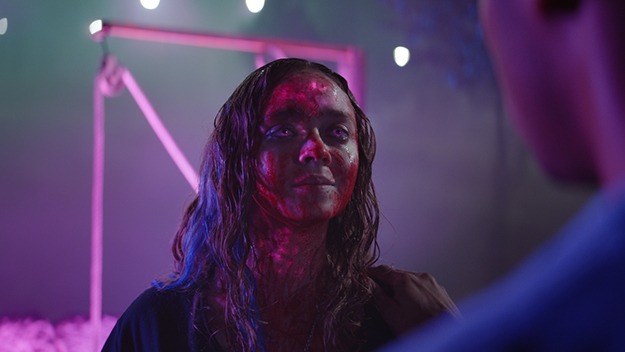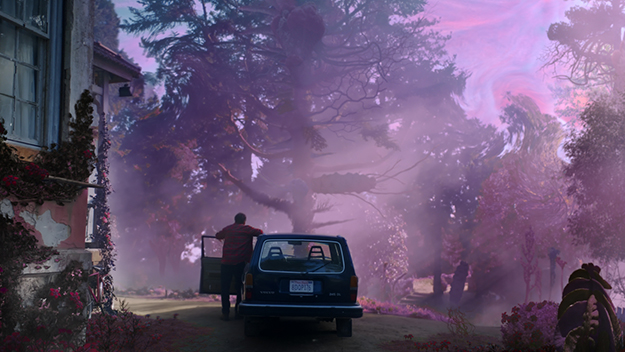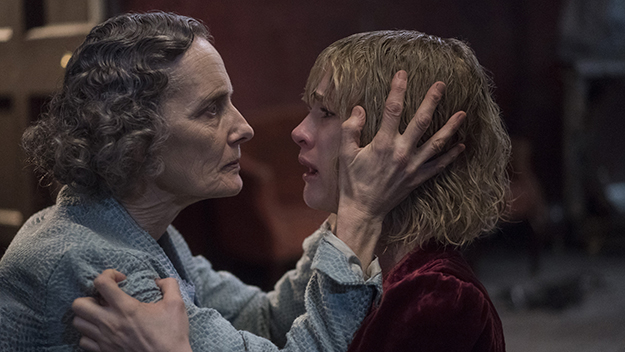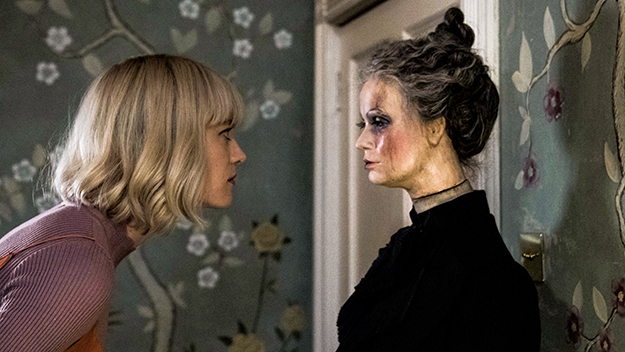Deep Focus: Color Out of Space and The Turning

Color Out of Space (Richard Stanley, 2019)
This week, the sublime becomes ridiculous, and the ridiculous becomes a trip, in two updates of horror classics considered high points of their masters’ voices: Floria Sigismondi’s The Turning, an adaptation of Henry James’s 1898 novella, The Turn of the Screw, set in 1994, and Richard Stanley’s present-day Color Out of Space, based on H.P. Lovecraft’s 1927 short story, “The Colour Out of Space.”
Lovecraft praised The Turn of the Screw for its “truly potent air of sinister menace” and its “rare and mounting tide of fright,” while mocking James’s prose for “inevitable pomposity and prolixity” and for being “perhaps too diffuse, too unctuously urbane, and too much addicted to subtleties of speech.”
Edmund Wilson, an eminent Jamesian, denigrated Lovecraft’s “incessant effort to work up the expectations of the reader by sprinkling his stories with such adjectives as ‘horrible,’ ‘terrible,’ ‘frightful,’ ‘awesome,’ ‘eerie,’ ‘weird,’ ‘forbidden,’ ‘unhallowed,’ ‘unholy,” ‘blasphemous,’ ‘hellish,’ and ‘infernal.’”
So who fares better at the cinema? The precise and delicate James, whose work pivots on artful ambiguity? Or the extravagant, baroque Lovecraft, who heralds his spine-tingling effects and then relentlessly repeats and explains them?
This time out: No contest. Color Out of Space comes to the screen as a febrile, energetic phantasmagoria, shot through with Lovecraftian weirdness. The Turning so consistently trashes James’s psychological terror, it should have been called The Screwing.
In Color Out of Space, Stanley and cowriter Scarlett Armaris hew to the original storyline of a meteorite that lands on a Massachusetts farm and releases a vaporous invader that assumes no earthly form and takes no prisoners. This gaseous plague of a monster settles in a water well, then “burns” and “sucks” the life out of anything organic. It can be described only as an unearthly color (in the movie, a blur of shocking pinks, purples, and reds).
Hydrologist Ward Phillips (the name is a Lovecraft pseudonym; the actor is Elliot Knight) begins the film by intoning Lovecraft’s own descriptions of Massachusetts’s ancient forests: “West of Arkham the hills rise wild, and there are valleys with deep woods that no axe has ever cut. There are dark narrow glens where the trees slope fantastically, and where thin brooklets trickle without ever having caught the glint of sunlight.” He ends it paraphrasing Lovecraft’s vision of “a colour out of space…from realms whose mere existence stuns the brain and numbs us with the black extra-cosmic gulf it throws open before our frenzied eyes.”
In between, writer-director Stanley stays true to Lovecraft’s vision of insidious dread while revising Lovecraft’s atavistic notions of a New England farm family. The film’s funky paterfamilias, Nathan Gardner (Nicolas Cage), has moved to his late father’s country place with his stockbroker wife Theresa (Richardson) and their three children: Lavinia (Madeleine Arthur), a budding teen Wiccan with Bette Davis eyes; affable adolescent pothead Bennie (Brendan Meyer); and sweet, bespectacled young Jack (Julian Hilliard). Nathan, a failed artist, has decided to turn the place into an alpaca farm (he’s convinced it’s the meat of the future) while Theresa struggles to conduct her business online despite an erratic dish connection. Lavinia enacts Wiccan rituals to rid her mom of breast cancer and return the clan to city life when she isn’t wigging out about living in the sticks. Bennie gets high and watches NASA videos with the estate’s reclusive squatter, electronics expert and omniscient doper Ezra (Tommy Chong).

Color Out of Space (Richard Stanley, 2019)
According to Daniel Noah, a cofounder of the film’s production company, SpectreVision (one of his partners is Elijah Wood), the producers were drawn to Stanley’s adaptation because it was so “intense” and “faithful” and “there’s nothing funny about Lovecraft.” But there is something funny about this movie: it riffs on that overused phrase “the new normal.” This family already lives with the absurd: the alpacas register as four-legged sight gags whenever they lope into view. Cage plays Nathan as both a man on the verge of a nervous breakdown and the personification of a dad-joke, whether breaking into opera, or shifting accents from Trumpian blowhard to nasal cringe comedian.
For the Gardner family, the abnormal morphs into “the new new normal.” When the rampaging color zaps two family members who then merge into each other, the survivors whisper bromides into the dominant creature’s ear. By the third act, the action grows so furious there’s no time for Lavinia to tell her dad that the color has guzzled one brother way down deep into the well or for Nathan to notice that she’s carved magic symbols into her flesh.
Lovecraft provides Stanley with a sturdy frame: When you make a film called Color Out of Space, you don’t have to color between the lines. The director throws everything into it, including a kitchen sink, and then fills the sink with blood. It’s diverting, lively, and forgettable because Stanley pitches quirky touches and grisly coups in the same comic-dramatic register. Reddish flowers start covering the Gardners’ grounds (a shout-out to Philip Kaufman’s Invasion of the Body-Snatchers?), and a mutant insect provides a glimpse of Mantis vision (like Karl Struss’s subjective camera for the 1958 The Fly). Nathan’s flesh turns scaley/leathery, animal corpses pile up with stomach-turning radiation damage, and a shower stop becomes a disgusting, circular white slug. Lovecraft’s premise gives Stanley carte blanche. He strews references to kindred works, such as Aleister Crowley’s The Book of the Law and Algernon Blackwood’s The Willows, and shoehorns in horrific anatomical fusions that he may have been envisioning since he was fired off The Island of Doctor Moreau (1996). He even includes a clip of his Moreau star, Marlon Brando, in One-Eyed Jacks.
All this may form a lucid pattern inside Stanley’s mind, but his adaptation lacks emotional structure. Instead of laying down an affective arc for us to follow, the director spirals into accelerated entropy. Cage gives an outsized yet modulated performance, and Richardson is touching to the bestial end. But the characters fly apart from the centrifugal force of the explosive goop and gore and spectacle. The one exception is Tommy Chong, who oozes countercultural authority as a zonked-out survivor. “It’s in the static, it’s in the moisture, it’s in here, it’s out there, what’s out there is in here now,” he says, like a true shaman. We believe him.

The Turning (Floria Sigismondi, 2020)
Joely Richardson also shows up, to no avail, in The Turning. This movie mutilates James’s plot about a governess who believes her two charges are possessed. The result is a “gotcha!” thriller that never grabs the audience. Mackenzie Davis, so confident as the night nanny in Tully (2018), flounders embarrassingly as schoolteacher Kate, who takes a job as live-in nanny to seven-year-old Flora (Brooklynn Prince) at a decaying old mansion. (James’s governess is nameless.) “I love teaching, but I want to make a difference,” Kate explains to her jolly roommate Rose (Kim Adis), in a typically inept and baffling line. (Chad and Carey W. Hayes, authors of the 2013 hit The Conjuring, wrote the screenplay.) Richardson plays her delusional asylum-bound mom, who doesn’t have much screentime but is crucial to the calamitous finale.
Director Sigismondi telegraphs shocks that she’s too incompetent to deliver. She sets out to wallop us from the prologue, when Kate’s predecessor, Miss Jessel, struggles to leave the estate and escape the clutches of stable manager Quint, as little Flora watches from her window. (We swiftly learn that Jessel disappeared and Quint died.) Morbid dolls and mannequins and a skeletal specter creep out Kate as soon as she enters the premises. When fifteen-year-old Miles (Finn Wolfhard) bursts in unexpectedly, tossed out of boarding school for banging a classmate’s head against a bathroom floor, he and Flora team up to spook their nanny before you can say “bad seeds.”
The moviemakers blurt out and vulgarize everything that James leaves teasing and open to suggestion. Quint does represent “toxic masculinity.” But in this film, it’s not enough for us to learn that he seduced Jessel and corrupted Miles: Kate must discover that he was Jessel’s harasser, assaulter, and worse. The Hayes’s adaptation is as crude as it is puritanical. The screenwriters delete the character of the children’s seductive uncle, and with it the sexual thread in the tutor’s own unsteady psyche. (Joely Richardson’s grandfather, Michael Redgrave, played the uncle with peerless urbanity in Jack Clayton’s brilliant 1961 adaptation, The Innocents.)

The Turning (Floria Sigismondi, 2020)
James’s novella sensitizes readers to the unknowable and uncanny, whether we believe the ghosts are real or projections of the governess’s insecurities. It’s as much about illusory “truth” as Rashomon. This film is simply schizophrenic. It presents several scares “objectively,” like a dummy’s head turning on its own after Kate walks out of sight, and renders others in such a hodge-podge of blurry, clattering “boo” effects that it’s impossible to tell who’s falling apart, the heroine or the director. Sigismondi transforms her fragile governess and unreliable narrator into the heroine of a “believe the woman” narrative. She’s a paragon of frankness and egalitarianism compared to the imperious housekeeper, Mrs. Grose (Barbara Marten), a queen of denial who views herself as the protector of the clan and especially its two young “thoroughbreds.” I began to fantasize about other great female roles Sigismondi could film in altered form—an Anna Karenina who throws Vronsky under the train, a Madame Bovary who feeds arsenic to her husband.
Sigismondi stumbles her way toward a bombastic, pseudo-psychological ending that undercuts her own terrible ideas and leaves audiences bemoaning their wasted time and money. She directs like a party trickster who tries to pull the tablecloth out from under the dinner setting and instead sends the dishes smashing to the ground. The Turning begins as a crock and ends a shambles.
Michael Sragow is a contributing editor to Film Comment and writes its Deep Focus column. He is a member of the National Society of Film Critics and the Los Angeles Film Critics Association.







